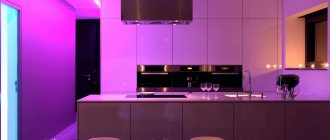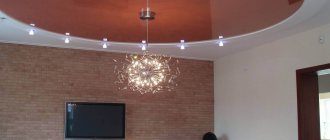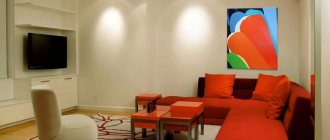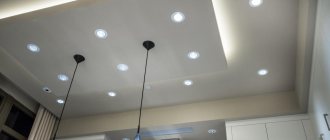Who is a lighting designer and why is one needed?
It is very difficult to think through a lighting strategy on your own without special skills. At first glance, the task seems feasible, but in practice it is rarely possible to correctly implement ideas. Common mistakes:
- Incorrect placement of lamps.
- Failure to comply with lighting standards.
- Inefficient distribution of sockets and switches.
- Lack of a plan for linking lamps to switching groups.
It is also important to understand the types of lighting and the characteristics of electrical appliances. In order not to delve into these issues, it is easier to trust a professional.
The main task of a lighting designer is to properly organize lighting. A specialist must be familiar with colors, interior styles, lighting equipment, and fashion trends. When developing the project, he is also guided by the climatic nuances of the region.
The first stage of a specialist’s work is creating a concept. The lighting designer evaluates the characteristics of natural lighting, plans the location of lamps, and considers the type and number of devices.
A professional knows how to complete the job in accordance with norms and standards. It will help organize designer lighting that will bring comfort to all occupants of the rooms.
An example of successful room lighting design
Pros and cons of chandeliers
The most common type of lamps that is used in the interior of any room and style are pendant and ceiling chandeliers. They use different types of lamps, they differ in style and design, but the most important parameter when choosing is the material from which the chandelier is made.
| Material | pros | Minuses |
| Metal |
|
|
| Glass |
|
|
| Tree |
|
|
| Crystal |
|
|
| Plastic |
|
|
| Textile |
|
|
Chandeliers definitely look quite stylish and play up the overall stylistic idea of the interior, creating an atmosphere of warmth and comfort around them, but they also have disadvantages:
- Difficult installation.
- Difficulty in cleaning. In order to clean the chandelier well, you will first have to unscrew the shades and then screw them into place.
- High cost compared to conventional lamps.
- Not suitable for rooms with low ceilings.
- Markedness. Decorative chandeliers located under the ceiling collect a lot of dust due to the abundance of hanging elements.
Despite their beauty, they are very difficult to install and maintain.
Chandeliers always look very stylish
See also: Arch design: choice of shapes and materials
How interior lighting affects the space of rooms
Good lighting will highlight interior details, visually enlarge the space and make the room cozy. Some more interesting facts:
- Ceiling lights placed in a row will visually add height to the room.
- Reflective elements on the walls will visually expand the space.
- Lamps located longitudinally on the wall will visually “stretch” the room.
If there is not enough light in the room, it will look gloomy. Even the original design of the home will not correct the situation - all furnishings will appear in an unfavorable light. A poorly lit room will visually appear smaller than it actually is.
We present a photo that shows successful and unsuccessful lighting options. The image perfectly illustrates the influence of light on the perception of space.
An example of successful and unsuccessful room lighting
Rules and regulations
The use of artificial lighting has necessitated the development of clear requirements for its parameters. A person’s well-being, his emotional state, his ability to work efficiently, and the preservation of good vision depend on how well it is organized. Therefore, different premises have their own specific standards. It is easy to guess that for a study and a closet their values will not be the same. The main document that you need to rely on when calculating the number and power of appliances in an apartment is SNiP 05/23/95. It regulates natural and artificial lighting of residential, educational, commercial, industrial premises, as well as public gardens, parks, streets, squares.
The unit of illumination is Lux -1 lumen per square meter. m. The norm depends on the purpose of the room. For example, for a living room, bedroom or dining room, 150 Lux is enough. In the nursery it is necessary to provide 200 Lx, in the bathroom or kitchen already 250, and in the office all 300. In the hallway, pantry, attic or basement you will need 50-60 Lx.
Scenarios and rules of modern lighting
The main rule of lighting design is the choice of lamps for specific tasks. You should not place devices in the room that are unlikely to be used. To avoid mistakes, you need to think through the scenario.
You can combine several scenarios in one space. The most common option is a multi-level lighting system. This solution is especially relevant for spacious rooms. The scheme includes:
- Main ceiling lighting.
- Additional lights in certain areas of the room.
- Accent lighting for interior items.
- Creative lighting.
You can experiment with designer lighting as much as you like, but the organization of the main thing should come first. One chandelier or lamp is not enough, so it is important to think about how many light sources there will be in the room and how to arrange them. To do this, experts draw up a lighting scheme.
Multi-level lighting in the kitchen interior
Multi-level designer lighting in the living room interior
Does lighting have a style?
To answer this question, you need to take a closer look at the devices that help fill the room with light. The style directly depends on the characteristics of the lamps - shape, color, materials of manufacture. In classic interiors, chandeliers and sconces with crystal pendants are welcome. In modern ones, chrome-plated devices reign. Pop art is filled with bright, sometimes awkward lampshades. The interior of a country house in the Provence style will be “warmed” by textile lampshades. A loft is unthinkable without production spotlights, track systems and spots. Forged or wooden structures add country flavor. Art Nouveau is made even more impressive by intricate lines and shapes. The chosen style affects the number of light sources, their power and placement.
Apartment lighting scheme
The first stage of creating a lighting system is preparing a lighting design project for each room. It's time to decide on the types and number of lamps and lamp power. The plan must indicate the lighting points in accordance with which the light sources should be located.
It is very important to choose switches and determine their location. Typically, each group of lamps is connected to a specific mechanism. Therefore, you need to place all devices so that they are convenient to use.
An excellent option is pass-through switches. With their help, you can control lighting fixtures from different points in the apartment. To implement such a solution, you need to think through the wiring diagram in advance.
Some more useful tips:
- Sockets and switches should be located in easily accessible places. According to the standard, at least one socket must be provided per 6 square meters of space. You can place more devices if the lighting system contains floor lamps, sconces and lamps that require individual connection to the network.
- It is better to place sockets at a height of 0.5-0.8 m from the floor. Switches - at a height of 0.6-1.5 m.
- To determine the optimal number of lighting fixtures per room, you need to multiply the area of the room by the recommended light level.
Advice! To be able to regulate the illumination from lamps, you can install special dimmer switches.
Kitchen and dining group
Many people are interested in the question of what is the role and purpose of lighting in various rooms. The kitchen and dining room should also be equipped with a lighting system. This is necessary for comfort and aesthetic harmony.
If you plan to install lamps directly above the surface of the tabletop, then their height should be approximately 60 centimeters. This replacement of artificial lighting is very convenient, as it creates maximum comfort for cooking.
For small rooms it is worth using point systems, as chandeliers can overload the interior. Elegant lamps made of natural wood or metal are perfect for the kitchen.
Lighting fixtures in the interior
Interior lighting is represented by different types of lamps. Instrument options:
- Chandeliers.
- Hanging lamps.
- Spotlights.
- Sconce.
- Desk lamp.
- Floor lamps.
Let's talk about each group of lamps. You will learn about the features of the products and be able to evaluate examples of interesting models.
Chandeliers
A chandelier is often used as the centerpiece of a lighting system. It becomes a bright accent and a source of powerful light flux. However, it should not become the only device in the room.
The design of the chandelier must be chosen depending on the height of the ceiling and the size of the room. If the room is small, a massive model will visually “steal” the space.
The design of the chandelier must correspond to the trends of the chosen interior style. Models with crystal horns and pendants will look great in classic and luxurious art deco. Modern trends allow you to experiment with the shape, color and size of devices.
The elegant Vitaluce pendant chandelier will fit perfectly into the living room. For the bedroom you can choose the fashionable Vele Luce Modena model. And Favorite Bulla will look great in a modern kitchen design.
buybuy
Vitaluce chandelier for the living room
buybuy
Vele Luce Modena chandelier for the bedroom
buybuy
Favorite Bulla chandelier for the kitchen
Advice! If there are several chandeliers in the room, it is better to choose models that are identical or similar in design.
Pendant lamps
Pendant lamps are often present in the lighting scheme of an apartment. They provide directional streams of light, so they are used to highlight individual areas of the room. Most often they are placed above kitchen and gaming tables, and a bar counter.
Suspended models are ideal for lighting design in rooms with high ceilings. Devices are rarely placed individually - more often in groups of 3-4 copies.
Examples of original lighting sources: the exquisite Globo Ticon model and the stunningly interesting Lussole Loft Bristol lamp in the shape of a badminton shuttlecock.
buybuy
Pendant lamp Globo Ticon
buybuy
Pendant lamp Lussole Loft Bristol
Sconce
Sconces are wall lamps that serve for local lighting. There are several types of products: open, near-surface, models on a bracket.
Near-surface specimens fit tightly to the wall. They are usually miniature lamps enclosed in a transparent housing. Such sconces emit soft reflected light, so they serve more as decorative lighting. Suitable for the interior of a bedroom, nursery, living room.
Open lamps are lamps without a shade. Outwardly, they are very similar to candles. Most often they decorate offices, living rooms and hallways. The sconces shine quite brightly, so they are suitable as a source of local lighting.
Wall sconces are lamps mounted on an adjustable arm. If desired, they can be brought almost close to the wall or, conversely, moved further away. Such devices are an excellent option for an office, library, or hallway.
Surface sconces in the interior
Sconce on a bracket in the interior
Open sconces in the interior
Desk lamp
Table lamps are a popular attribute in lighting design projects. From the name of the lamps it is clear that these are devices intended for placement on horizontal surfaces: countertops, shelves, cabinets. The products do not require special installation and look great in any room.
Table lamp in the interior
Floor lamps
Floor lamps are floor lamps on a high base. The devices are equipped with figured lampshades or laconic shades. A huge variety of designs allows you to choose a model to suit any interior style.
Original floor lamp in the interior
What kind of light is there?
Light is the product produced when an object is heated. That is, the higher the temperature, the brighter the lighting. It is divided into two main types:
- natural;
- artificial.
Natural light will make any environment comfortable and can maximize reflections from surfaces and mirrors. In other words, it is sunlight. To have more room in the room, you should think about increasing the window openings.
Natural light enters the room through skylights - transparent windows or doors
Artificial lighting is set by a certain set of lamps
It is worth considering that it changes depending on the time of day, weather, location. The Northern Lights are considered more permanent. When choosing lighting fixtures, you must take into account the amount of natural light entering the premises of the house or apartment.
What the lamps emit is considered artificial light.
Artificial lighting is divided into functional and decorative
Spot lighting in the interior
Spotlights (spots) deserve special attention. They emit directional streams of light that spread at a certain angle. As a result, you can illuminate the entire space of the room.
Types of spotlights:
- Built-in.
- Invoices.
- Track.
Recessed luminaires are devices whose housing is hidden in the ceiling or other surface where they are installed. The products are compact in size and versatile. They are almost invisible in the interior and perfectly complement more original lighting sources.
Surface-mounted lamps are mounted to the plane of the wall, furniture or ceiling so that the body is located in plain sight. Most often, such models have a laconic design, so they are not noticeable. They go well with other lighting fixtures and fit into any interior.
Track lamps are a relatively new trend in lighting design. This is the name given to devices mounted on the busbar trunking. The main advantage of the models is the presence of a rotating mechanism, which makes it possible to change the direction of the light flow.
Important! If spotlights appear as the main sources of lighting, they must be evenly positioned on the ceiling. The optimal distance between devices is no more than 1.5 m.
Track lamps in the interior
Spotlights in the interior
Lighting design rules
To avoid mistakes when organizing space lighting, you need to consider several rules.
Planning basic, task and decorative lighting
General lighting consists of ceiling lights that provide uniform and diffused light. Most often these are chandeliers with different bulbs, lampshades and shades made of fabric or glass. In no case should a lamp on the ceiling cast shadows or reflections - this will ruin the whole atmosphere and irritate the eyes.
If you choose a large chandelier as the main lighting, the light will be different in some parts of the room, but still without shock
In the work area, it is better to install lamps that provide directional light: floor lamps, sconces or table lamps. This lighting should be brighter than the main one. In the kitchen, the work area is the dining table and food preparation area. In addition, the place for reading books, the head of the bed, the place for homework or children's entertainment needs special lighting.
The level of illumination of the workplace should provide an optimal balance that does not tire the eyes
Only when the main and task lighting is conveniently equipped can you think about decorative lamps.
Selection of characteristics
The choice of lamps depends primarily on the lamp itself, the expected frequency of its use and functionality in the apartment. The light bulb in the device solves almost everything. In some situations, only classic incandescent lamps are suitable, while in others LED lamps are needed.
Incandescent lamps are the cheapest, LED lamps are the most expensive
The higher the temperature of the light bulb in degrees Kelvin, the cooler the light it emits. For a bedroom, up to 3000 (incandescent lamps) is enough, for a workplace - up to 5000. Lamps above 5500K are already used in offices. It is not recommended to use cold light in the dining area or near mirrors.
Calculations
No designer will bring a project to life without correct calculations. And this is not a question about finances at all. It is necessary to predict whether all devices will work in one room. There will be unpleasant situations.
Planning your lighting helps you avoid common mistakes that can ruin your interior design idea.
To implement this stage, it is recommended to contact specialists, since not all designers do this themselves.
Lighting Design Trends
Interior fashion tends to change quickly. This directly applies to lighting design. We tell you what trends professionals use in decorating rooms.
Eco trends
Lighting devices made from natural and environmentally friendly materials are gaining popularity. Lamps with lampshades made of wood, thick paper, or stone look impressive. Lamps with wicker shades deserve attention. Such models are appropriate in almost all modern interior styles.
Chandelier made of elk antlers in the interior
Corrugated cardboard chandelier in the interior
Laconism and minimalism
First of all, this category of trends includes compact lamps in transparent shades. The devices look original and create a special atmosphere in the room. They are suitable as additional sources of general lighting and accent lighting of certain areas of the room.
Lamps in laconic round shades are at the height of fashion. They are considered universal because they combine well with other lighting devices.
Chandelier in the style of minimalism in the interior
Unusual shapes
Lamps with non-standard configurations are becoming fashionable. Triangular, square and trapezoidal lampshades will be a wonderful accent in modern designs. Lamps with balloon-shaped lampshades are very popular. They are ideal for installation in a nursery.
Original chandeliers in the interior
The influence of lighting on emotional state
Not only the appearance of your apartment, but also the mental and emotional state of its inhabitants depends on the choice of lamps. Scientists have found that the lighting that affects us has many properties that can be both beneficial and harmful.
- Yellow light is a classic option that people are unlikely to ever give up. This color creates a cozy atmosphere and is good for the eyes.
- Due to white lighting, human performance increases. But if the sharpness of such light is too high, fatigue occurs quickly.
- Red energizes and invigorates, increases blood pressure.
- Orange color provokes an improvement in appetite and an increase in heart rate.
- The blue light has a relaxing effect and lowers blood pressure.
- Green lighting is used in bedrooms and children's rooms. It is soothing and relaxing and very comfortable on the eyes.
- Violet and blue light are not used for living spaces and rooms with long stays. These colors are depressing and irritating.
Blue light will help you relax
Each color has its own effect on a person
Emotional state may depend on lighting
See also: Lining in the interior: types, photos, tips
Pros and cons of lamps
The latest generation of lamps, which are extremely popular, are LED or LED lamps. Their success in the market is due to the many advantages of such lighting:
- Durability. Service life more than 50 thousand hours.
- Energy saving.
- Economical.
- High efficiency.
- Ability to change the color, brightness and temperature of lighting.
- Compact and flexible modules that allow you to implement many design ideas.
- Strength.
- Environmentally friendly.
- Safety. Such lamps have an extremely low risk of fire.
Regarding the disadvantages of LED lighting, it is worth saying the following:
- The high cost may scare you at first, but it is fully compensated by the long service life and cost-effectiveness of such devices.
- An LED driver is required to provide power to the device.
- LEDs tend to lose brightness and their light becomes dimmer.
- Replacing a burnt-out LED can be problematic.
Using lamps you can highlight specific areas
LED lamps are very popular at the moment.
Sometimes lamps are used as a decorative element
See alsoRules of true masculine garage design
First impression: hallway
The room that makes the first, and therefore the main and most memorable impression on us when we enter the apartment. The main feature that should be present in every hallway is functional lighting that matches the interior. The selection of lamps in the corridor and hallway is approached responsibly, because there are no windows or natural light. There are general principles for creating proper lighting, check out:
- A dark corridor creates a tiring atmosphere and a bad mood;
- The main interior of the house should be combined with the hallway lighting;
- Corridor lighting will be divided into local and main; it is important that they are combined and together create the ideal combination;
- Average lighting parameters for a hallway are 1 lm per 1 sq. m (50 – 80 lux);
- Light is distributed evenly along the corridor, regardless of its shape and size.
Linear luminaires
Uniform light in a well-thought-out layout can be created by LED linear lamps - they fit perfectly into the modern interior of the hallway; these are the most popular light sources for this room. The reason for this preference is clear: reflected light from the ceiling and walls illuminates the room and helps avoid the formation of any shadows. Linear recessed luminaires are attached to any ceiling without violating its integrity. Linear luminaires also differ in installation method. The HOKASU collection includes series of surface-mounted, suspended, recessed and putty-mounted installations. We also produce modular designs that allow you to create various shapes: ring, hexagon, zigzag, triangle, square, molecule.
Recommended models:
- Pendant/surmount lamp HOKASU S50, HOKASU 35/40 U&D, HOKASU S35
- Recessed lamp HOKASU 100/40 IN, HOKASU 35/25 IN
- Recessed lamp (for putty) HOKASU S35 edgeless, HOKASU 49/32 edgeless
In the hallway, you can also use LED backlighting with directional light to emphasize the significance of a painting, artwork or architectural details. Proper lighting is designed to make your room the most comfortable and cozy. Read more about hallway lighting in the article.











